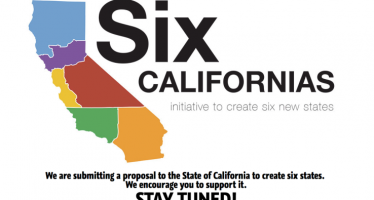State Voters Don't Want Tax Hikes
DEC. 8, 2010
Rebuttal to Dan Walters
By WAYNE LUSVARDI
Sacramento Bee columnist Dan Walters is calling for a $20 billion tax increase to permanently plug the structural budget deficit in California on the grounds that it would have virtually no impact on the state’s $1.9 trillion economy – (“California’s Budget Gap is Political, Not Economic”) But what Walters advocates would nullify the recent California social contract made by voters of both major parties on Nov. 2.
California voters sent a message loud and clear at the recent past election that they want politicians in all statewide and district offices that were up for re-election to be from the Democratic Party, but they also want no new taxes or fees – per Prop. 26 (“Supermajority Vote for New Fees & Taxes”). A coalition of both Democrats and Republicans voted for Prop. 26, as at least about 1,250,000 Democrats voted for Prop 26.
The only exception to this social contract is that Prop. 25 (“Majority Vote for Legislature to Pass Budget”), which provides for the state legislature to pass the state budget by simple majority rather than the former two-thirds rule under Proposition 13.
You can balance a budget two ways: high or low. The picture that emerges from the recent state vote on political offices and propositions is that the electorate wants the budget balanced low, not high as contended by Walters. But if the majority Democratic Legislature and governor balance it high by passing a new bill to raise $20 billion in taxes it would have to be ratified by the voters who just gave a clear message “no more new taxes.” So the only interpretation that seems to make sense is that the electorate wants the budget balanced low – more specifically $20 billion lower.
Walters writes:
“Closing the budget deficit, then, is not an economic issue, the propaganda from left and right notwithstanding. It is a political issue that reflects not only the ideological polarization of the Capitol but (also) the apparent inability of ordinary Californians to comprehend public finance.”
The notion that ordinary Californians don’t “comprehend public finance” is not indicated by the new social contract that has emerged. Maybe the voters intuitively know something that Walters doesn’t, such as the total tax burden on Californians.
Walters fails to mention that California already has the highest gasoline tax and capital gains tax on real estate, the next highest sales tax, and a utility user’s tax and a redundant school parcel tax not found in other states. The only places to look for new taxes would be to raise corporate income taxes or property taxes. But the home voter coalition just sent a message on Nov. 2 that they don’t want new taxes, especially fees or taxes imposed on real property.
| Property Tax | Sales Tax | Corporate Income Tax | Capital Gains Tax on Real Estate | Gasoline Tax | Utility User’s Tax | School Parcel Tax | Overall Rank by author |
| 18th | 49th | 33rd | 50th | 50th | 50th
California Only |
50th
California Only |
50th |
Source: Tax Foundation and author
Abolishing Prop. 13 protections for commercial properties would only cause even more retail property vacancies than today and cause an unintended wave of bankruptcies and foreclosures of small businesses with SBA loans collateralized by the equity in their homes. The budget deficit may be “political not economic” as Walters says. But what politician or party in their right mind is going to risk triggering a wave of commercial foreclosures in what now appears to be a long-term economic deflation like what happened from 1929 to 1949? And the recent jobs report shows that two-thirds of newly created jobs are part-time in food service and retail sales, etc. that would be vulnerable if commercial property taxes were increased.
The state Legislative Analyst’s Office did a study in 2008 indicating that the assessment ratio for commercial-industrial properties was 60 percent. This study is widely cited as evidence that commercial properties are 40 percent under-taxed. But the Moody’s Commercial Property Index shows a decline of 45 percent to 50 percent since 2007 after the bursting of the financial bubble.
So commercial properties today are likely to be at near parity with their current market values and are less likely to be under-taxed.
Another issue with raising $20 billion on the backs of commercial properties is that logistically it would take about two years to realize any tax collections, as county assessors would have to hire a small army of appraisers to mark commercial properties to market prices. Moreover, it is not feasible to shift to online computer valuation services for commercial properties as it is for residential properties (Zillow), if for no other reason than commercial properties have many potential uses and residential properties do not. This doesn’t even take into consideration that any split commercial-residential property tax roll would result in the market adjusting commercial property prices downward accordingly in a zero sum game of de-capitalization.
A tentative analysis by this writer of school funding reforms under Assembly Bill ABX-4-2 (2009) indicated that eliminating many “categorical” (i.e., “politically protected”) job categories resulted in saving about 34 percent of the unrestricted state general fund budget for K-12 public schools for the 2010-11 school year.
By this writer’s estimate elimination of this “job bloat” on school taxes equated to almost $11 billion. Without ABX-4-2 the state budget deficit for 2020 would have ballooned from about $20 billion to $31 billion by this writer’s calculation.
Which begs the question: How much of state government is still loaded with similar “bloat?” If the non-education portion of the state budget 60 percent of about $90 billion, and 34 percent of that also is “bloat,” that reflects about $18 billion. This is close to closure of the state structural budget deficit.
But you say, “Wait a minute, what are we going to do with all those laid off former categorical protected state employees? The state’s unemployment and welfare funds are already running in the red. And I thought we had a deal on Nov. 2: fiscal conservatism but social liberalism?”
But this presumes that government workers get to go to the head of the line and keep their jobs over the private sector. This is an undisclosed presumption that undermines Walters’ argument. He wants a $20 billion tax increase on the backs of the private sector only. That wasn’t part of California’s “new deal” of Nov. 2.
We’re going to have to further eliminate categorical jobs bloat, reduce lucrative state employee benefits packages, and find a way to control the costs of rogue environmental lawsuits if we’re going to close a $20 billion budget gap. And if we don’t, we will have to cut services on the backs of people who are arguably more deserving and needy.
State budgets and taxes require the legitimate “consent of the governed” (i.e., legitimacy, or the belief in another’s right to rule). Like it or not the voters have devised their own new social contract of liberal representation but fiscally conservative taxation. Those journalists, opinion pollsters and politicians who now want to renegotiate or reinterpret California’s “new deal” of Nov. 2 for a permanent $20 billion tax increase because it was made by those who purportedly are “unable to understand public finance” should tread carefully. The gods of political legitimacy often find ways to punish those who violate the social contract.
Related Articles
Low turnout in 2014, high initiative count in 2016
Elections have consequences. Ironically, California’s abysmal election turnout this November has teed up a veritable flood of ballot initiatives for 2016.
State’s most sickening building
JUNE 22, 2010 By KATY GRIMES The Board of Equalization employees are sick of work. Actually, they are sick because
Concerns raised over taxpayer disclosure bill
A bill that recently passed the state Assembly would make it easier to disclose confidential tax information and harass businesses,




